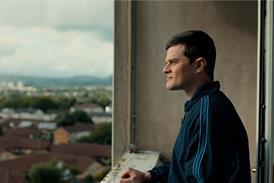A decade after the adaptation of The Wittman Boys (1997) which delved with a vengeance into the evil lurking behind childhood innocence, Janos Szasz goes back to the diaries of same writer, Geza Csath, and comes up with the cinematic equivalent of an Edgar Allan Poe horror poem.
Taking place in 1913, inside a psychiatric hospital, Opium: Diary Of A Madwoman follows Dr Jozsef Brenner (Csath's real-life name), played by Danish star Ulrich Thomsen, and his encounter with 28-year-old manic patient Gizella (Norwegian actress Kirsti Stubo). It then develops into one of those rare film experiences where horror is not just a means for producing relief after catharsis, but an end in itself.
It would be difficult to single out another picture that starts and ends with an on-screen lobotomy, performed in close-up as it used to be done in the old days (by hammering a chisel into the narrow space between the eye and the nose of the patient to deprive him once and for all of the use of his brain). And these are mere bookends, holding up much more unsettling spectacles in-between.
Festivals will queue for this one - it won best director and cinematography at this year's Hungarian Film Week - but cinemas will find it is much more of a hot potato than it might appear, because Szasz's film isn't just scandalous for the sake of being scandalous but actually upsetting, which most other films of this type are not.
Csath (1887-1919), one of Hungary's most frighteningly brilliant literary figures, was a psychoanalyst, musicologist, writer, composer, journalist, self-avowed philanderer, a drug addict and a certified madman who murdered his wife and committed suicide after an aborted escape.
Szasz, obviously fascinated by this author, went straight for the jugular and tackled the man's memoirs, which have the distinction of being unusually tormented, unpleasant, perverse and shockingly candid.
In them, Csath observes and documents not only the old-fashioned treatment of mental disturbances and their clash with the modern Freudian approach or the strict disciplines of the nuns nursing the patients and the promiscuity hiding behind their robes, but also his own addiction to morphine and his own extensive sexual exploits, all of which he notes down in detail with a mixture of pleasure and disgust. His affinity to music plays a significant role, but nothing can compare with his obsession for writing.
This obsession eventually leads his relationship with a patient that has been turned over to him, Gizella, to an inevitable explosion. Brenner suffers from writer's block (not quite substantiated by the film, in which he keeps writing entries in his diary), Gizella, on the contrary, is possessed by an uncontrollable urge to write, everywhere and anywhere - if paper is not available walls will do just as well.
It's a sort of erotic fascination that drives her incessantly (she even masturbates with a pencil), and Brenner can't help envying her ease in putting thoughts into writing. Nor can he, once he starts reading, deny there is more to them than just the raving rants of a madwoman.
Convinced the devil has taken possession of her soul, Gizella wants it back, but none of the traditional methods work in her case - not being immersed in water nor electric shocks nor icy cold showers.
Brenner doesn't do much better with her either, for a while, until they become inter-dependent. He steals from her writings, she calms down to a certain degree and their closeness explodes in a night of hysterical lovemaking after which she believes herself to be his bride. His subsequent denial brings on her final demise.
Religious, political, philosophical and even scientific interpretations beg to be explored in Opium: this could easily be the portrait of a decadent, dried-up artist vampirising a fresh source of inspiration, and thereby destroying it. It could also be taken as the failure of science to master the human mind, the portrait of a totalitarian regime or of religious hypocrisy, and so on.
But the only effective way to look at it is as a journey into the world of the damned, who torture themselves and each other, be they doctors or patients, driven by demons they can't understand or control. Logic and reason can't help much; it is a purely emotional experience that one is sensible to, or not. For the former, the descent will be like a bad dream you can't rid yourself of, for the others, a bad dream you want to forget.
Szasz, undoubtedly one of the most gifted Hungarian film-makers of his generation, returns to fiction after a long stint on stage, some documentary work and plenty of teaching. In the meantime he has strengthened his hold on the refinements of filmic language, particularly in his work with the actors.
Ulrich Thomsen faultlessly handles the diseased aspects of Brenner's character and Kirsti Stubo's tour de force as Gizella is the kind of unbridled performance rarely seen on screen.
Tibor Mathe's virtuoso camera works wonders, whether in powerful close-ups (in one of them Stubo looks like Falconetti in Dreyer's Jeanne d'Arc) or in large, composite images of the madhouse.
The soundtrack, combining Beethoven and Scarlatti sonatas with modern experimental music, creates just the right kind of troubled atmosphere Szasz needs.
Production companies/backers
Hunnia Filmstudio
EuroArts Filmed Entertainment
International sales
H20 Motion Pictures
Producers
Andras Hamori
Pal Sandor
Executive producer
Berndt Helthaler
Screenplay
Janos Szasz
Andras Szeker
Cinematography
Tibor Mathe
Editor
Anna Kornis
Production design
Tibor Lazar
Main cast
Ulrich Thomsen
Kirsti Stubo
Zsolt Laszlo
Eniko Borcsok
Gyongyver Bognar
Roland Raba
Laszlo Kassai
Zoltan Szollosi
Geza Szollosi
Akos Horvath
Miklos Madi
Csaba Horvath
Dora Rozsnyai
Erika Molnar















![[Clockwise from top left]: Paul Thomas Anderson, Chloe Zhao, Ryan Coogler, Park Chan-wook](https://d1nslcd7m2225b.cloudfront.net/Pictures/274x183/9/0/0/1467900_writerdirectors_192733.jpg)


No comments yet